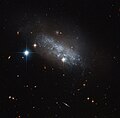Top Qs
Timeline
Chat
Perspective
Irregular galaxy
Class of galaxy From Wikipedia, the free encyclopedia
Remove ads
An irregular galaxy is a galaxy that does not have a distinct regular shape, unlike a spiral or an elliptical galaxy.[1] Irregular galaxies do not fall into any of the regular classes of the Hubble sequence, and they are often chaotic in appearance, with neither a nuclear bulge nor any trace of spiral arm structure.[2] This absence of structure in an irregular galaxy leads to little density waves in these galaxies. This makes irregular galaxies prime areas to study star formation without the effects of density waves.[3]

Collectively they are thought to make up about a quarter of all galaxies.[4] Some irregular galaxies were once spiral or elliptical galaxies but were deformed by an uneven external gravitational force. Irregular galaxies may contain abundant amounts of gas and dust.[5] This is not necessarily true for dwarf irregulars.[6] Irregular galaxies may also be formed in galaxy collisions.[7]
Irregular galaxies are commonly small, about one tenth the mass of the Milky Way galaxy, though there are also unusual cases of large irregulars like UGC 6697. Due to their small sizes, they are prone to environmental effects like colliding with large galaxies and intergalactic clouds.[8]
Remove ads
Types
Summarize
Perspective
There are three major types of irregular galaxies:[9]
- An Irr-I galaxy (Irr I) is an irregular galaxy that features some structure but not enough to place it cleanly into the Hubble sequence.
- Subtypes with some spiral structure are called Sm galaxies
- Subtypes without spiral structure are called Im galaxies.
- An Irr-II galaxy (Irr II) is an irregular galaxy that does not appear to feature any structure that can place it into the Hubble sequence.
- A dI-galaxy (or dIrr) is a dwarf irregular galaxy.[10] This type of galaxy is now thought to be important to understand the overall evolution of galaxies, as they tend to have a low level of metallicity and relatively high levels of gas, and are thought to be similar to the earliest galaxies that populated the Universe. They may represent a local (and therefore more recent) version of the faint blue galaxies known to exist in deep field galaxy surveys. These types of irregular galaxies also have high amounts of dark matter. [11]
Irregular galaxies are considered late-type along with spiral galaxies as opposed to early type elliptical galaxies. [12]
Some of the irregular galaxies, especially of the Magellanic type, are small spiral galaxies that are being distorted by the gravity of a larger neighbor.
Remove ads
Magellanic Clouds
The Magellanic Cloud galaxies were once classified as irregular galaxies. The Large Magellanic Cloud has since been re-classified as type SBm (barred Magellanic spiral).[13] The Small Magellanic Cloud remains classified as an irregular galaxy of type Im under current galaxy morphological classification, although it does contain a bar structure.
Gallery
- Blue compact dwarf galaxy ESO 338-4[14]
- ESO 486-21 is a spiral galaxy with a somewhat irregular and ill-defined structure.[16]
- NGC 2337 is an irregular galaxy that resides 25 million light-years away in the Lynx constellation.[18]
- UGC 4459 is an irregular dwarf galaxy located approximately 11 million light-years away in the constellation of Ursa Major.[19]
- Dwarf irregular galaxy known as PGC 18431[20]
- IC 559 is classified as a type Sm galaxy.[21]
See also
- Blueberry galaxy – Small and very active galaxies.
- Dwarf galaxy
- Dwarf elliptical galaxy
- Peculiar galaxy
- Galaxy morphological classification
References
External links
Wikiwand - on
Seamless Wikipedia browsing. On steroids.
Remove ads









